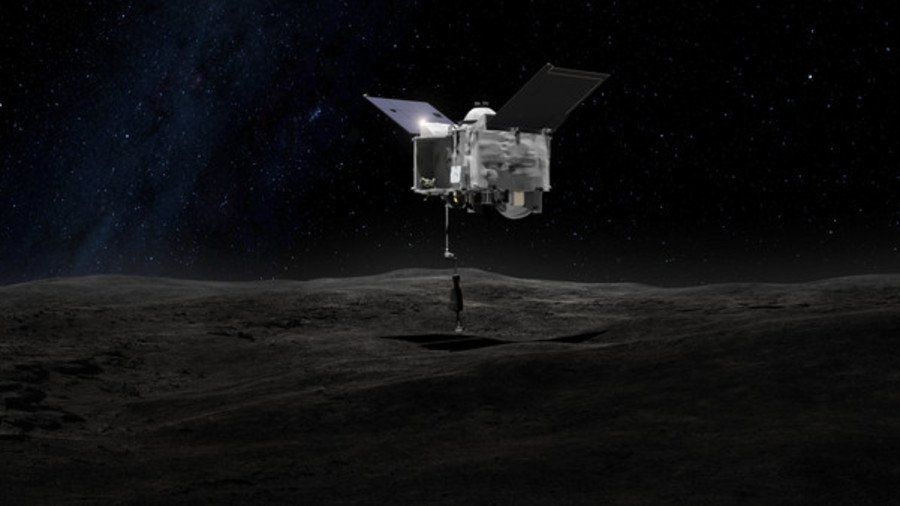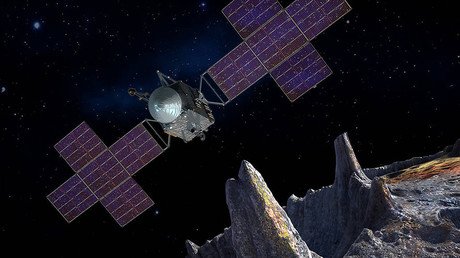NASA’s Osiris-Rex arrives at potentially Earth-bound asteroid Bennu

NASA’s Osiris-Rex robotic probe has completed its two-year, two-billion-kilometer journey to the skyscraper-sized Bennu asteroid in what could prove to be one of the agency’s most important missions yet.
Exactly one week after NASA landed a spacecraft on Mars, the Osiris-Rex craft’s odometer showed 1.2bn miles (2bn km) travelled. It completed the journey with a 20-second thruster burn to arrive within 12 miles (19km) of the 1,600ft (500-meter) diameter, diamond-shaped space rock. The elated reactions of the staff in mission control were captured on film; the culmination of a decade’s work.
Achievement unlocked: "We have arrived!" Our @OSIRISREx mission reached asteroid Bennu, where it will spend almost a year mapping and studying to find a safe location to collect a sample. Watch: https://t.co/zI282xjLzcpic.twitter.com/VMPs7SIfSf
— NASA (@NASA) December 3, 2018
“My heart-rate is three times faster than normal but I’m super-excited. Watching the team celebrate such an amazing milestone brings personal joy to me in so many ways I can’t even explain,” Heather Enos, the Osiris-Rex deputy principal investigator said of the momentous occasion.
One of the primary objectives of @OSIRISREx is to understand the Yarkovsky Effect - a non-gravitational force that can change an asteroid's orbit. We must measure the effect to accurately predict whether Bennu will impact the Earth or not.https://t.co/oh4qkS27j6https://t.co/UX9S7kYNtL
— Dante Lauretta (@DSLauretta) December 3, 2018
Osiris-Rex, which stands for Origins, Spectral Interpretation, Resource Identification, Security-Regolith EXplorer, began its journey in 2016 with a launch from Cape Canaveral in Florida.
Hello, asteroid Bennu! Our @OSIRISREx spacecraft flew over 2 billion miles to meet you. Here, the spacecraft's camera captures a full rotation of the asteroid. OSIRIS-REx will study Bennu for almost a year & prepare to collect and return a sample to Earth. https://t.co/WG3vVeRoV1pic.twitter.com/2itcL6qxtC
— NASA (@NASA) December 3, 2018
The $800 million probe’s mission is monumental in scale and in importance. The NASA team is aiming to determine whether the potentially hazardous asteroid is, in fact, on course to impact the Earth and how we might be able to deflect or destroy it if it is.
“But this is all dependent on the outcome of a very close approach that Bennu has with Earth in September 2135,” Lindley Johnson, a planetary defense officer with Nasa’s Science Mission Directorate said, as cited by the Telegraph.
We’ll just need to wait and see. Rather, our great-great-grandchildren will need to see.
There is reportedly a one-in-2,700 chance of Bennu striking the Earth in 166 years, placing Bennu at number two in NASA's rankings of 72 potentially hazardous Near-Earth Objects (NEOs).
Divert, intercept, destroy: 4 ways NASA plans to save us from Earth-bound asteroids (PHOTOS) https://t.co/MWNUddjivfpic.twitter.com/nX2fS0jur2
— RT (@RT_com) November 4, 2017
In addition, scientists are hoping the mission will yield more information about the source of both water and life itself within our own solar system. Lastly, the mission will also provide more insights into the mind-boggling potential for asteroid mining in the future.
The mission marks the first attempt by a US craft to successfully land on an asteroid following Japan’s recent success with the Ryugu asteroid, which is approximately double the size of Bennu.
The Osiris-Rex mission is one of the most ambitious asteroid surveys to date, aiming to bring back between 60 grams (two ounces) and two kilograms of regolith (dust and gravel from the asteroid’s topsoil), the most extraterrestrial material retrieved since the Apollo mission landed on the moon.
To achieve this, the craft will establish a gradually tighter orbit by spiralling down to a distance of roughly six feet for its retrieval mission sometime in July 2020. The probe will extend its three-meter robotic arm to give the asteroid a ‘high five,’ blasting it with pressurized gas to kick up scree which will then be collected in a sterile holding chamber.
READ MORE: Cosmic fender-bender: NASA’s asteroid-hunting probe develops mysterious dent (PHOTO)
This will be made all the more difficult as the heat of the sun will alter the craft’s trajectory slightly, meaning mission control back on earth must keep a close watch to issue course corrections and keep the probe in place before it can establish a stable orbit early in 2019.
Current estimates indicate the space rock could pass between the Earth and the moon in 2135 and potentially even closer some time between 2175 and 2195, though preliminary findings on the composition and trajectory of the space rock are due to be announced Monday at the American Geophysical Union (AGU) meeting in Washington DC.
Today, our @OSIRISREx spacecraft reached a major milestone — arrival at asteroid Bennu. Watch as the team explains the mission's goals and how they maneuvered the spacecraft to precisely reach its target: https://t.co/2lvc69KiCupic.twitter.com/4bklGJsuQj
— NASA (@NASA) December 4, 2018
Think your friends would be interested? Share this story!














